新概念英语第一册第九课教案+练习
- 格式:ppt
- 大小:764.00 KB
- 文档页数:2
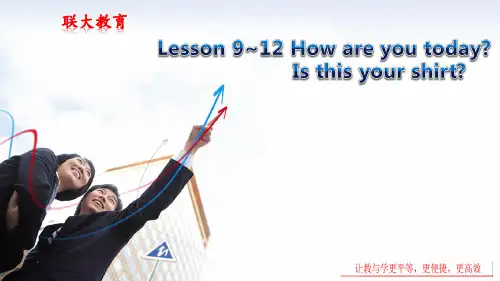
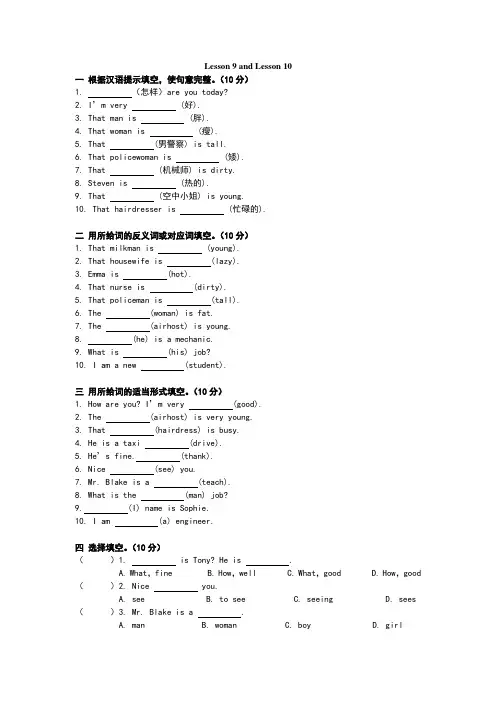
Lesson 9 and Lesson 10一根据汉语提示填空,使句意完整。
(10分)1. (怎样)are you today?2. I’m very (好).3. That man is (胖).4. That woman is (瘦).5. That (男警察) is tall.6. That policewoman is (矮).7. That (机械师) is dirty.8. Steven is (热的).9. That (空中小姐) is young.10. That hairdresser is (忙碌的).二用所给词的反义词或对应词填空。
(10分)1. That milkman is (young).2. That housewife is (lazy).3. Emma is (hot).4. That nurse is (dirty).5. That policeman is (tall).6. The (woman) is fat.7. The (airhost) is young.8. (he) is a mechanic.9. What is (his) job?10. I am a new (student).三用所给词的适当形式填空。
(10分)1. How are you? I’m very (good).2. The (airhost) is very young.3. That (hairdress) is busy.4. He is a taxi (drive).5. He’s fine. (thank).6. Nice (see) you.7. Mr. Blake is a (teach).8. What is the (man) job?9. (I) name is Sophie.10. I am (a) engineer.四选择填空。
(10分)()1. is Tony? He is .A. What,fineB. How,wellC. What,goodD. How,good ()2. Nice you.A. seeB. to seeC. seeingD. sees ()3. Mr. Blake is a .A. manB. womanC. boyD. girl()4. This shirt is old. It .A. isn’t newB. is newC. aren’t nowD. are new()5. Mrs. Ford is a .A. manB. womanC. boyD. girl ()6. is he? He is Italian.A. WhatB. What makeC. What nationalityD. How ()7. you French? No,I not.A. Is,amB. Are,amC. Be,amD. Are,is ()8. ? The man is a mechanic.A. What is his jobB. What is her jobC. What is he jobD. What is she job()9. is Steven? He is very hot.A. HowB. WhatC. What nationalityD. What make () isn’t a German car. is a Swedish car.A. HeB. SheC. YouD. It五句型转换(10分)1. That woman is thin. (就划线部分提问)is that ?2. That airhostess is young. (变为同义句)That airhostess is .3. He is a hairdresser. (就划线部分提问)is his4. He is very well. (变为同义句)He is very .5. Robert is Italian. (就划线部分提问)is Robert?6. My name is Robert. (就划线部分提问)is your ?7. It’s a Peugeot. (就划线部分提问)is it?8. That housewife is lazy. (变一般疑问句)that housewife ?9. That nurse is clean. (变否定句)That nurse is .10. Are you a teacher? (做否定回答),I .六根据汉语提示完成句子(10分)1. 今天你好吗?are you ?2. 那个机械师身上不干净.That is .3. 那个家庭主妇不勤快.That is .4. 那个护士是一个瑞典人.That is .5. 你是做什么工作的?is your ?6. 他叫什么名字?is his ?7. 她是一个瘦女人.Is a .8. 那个理发师忙吗?that hairdresser ?9. 那个护士怎样?is that ?10. 看看那个男人.At that .七补全对话. (10分)A: Hello,Helen.B: Hi,Steven.A: 1 are 2 today?B: I’m very 3 , 4 you. And you?A: I’m 5 . Thanks.B: How 6 Tony?A: He’s fine. 7 . How is Emma?B: She’s very well, 8 ,Steven. Nice 9 see you. Goodbye.A: Nice to see you,too. 10 .1. 2. 3. 4. 5.6. 7. 8. 9. 10.八完形填空(10分)A: 1 that my car?B: 2 the number?A: 3 it’s 24.B: No,that 4 your car. Your 5 is Number 28.A: Look! Is that 6 car?B: I think it is. 7 ,it’s a 28 car.A: 8 very good. Oh,where 9 my bags?B: Here 10 .A: Thanks,Goodbye!B: Goodbye!()1. A. Is B. Are C. It’s D. What’s (). How is B. Are C. What’s D. Where’s ()3. A. I think B. I don’t know C. I see D. I am()4. A. are B. isn’t C. not D. aren’t ()5. A. are B. car C. bus D. bike ()6. A. your B. his C. my D. her()7. A. No B. Not C. Fine D. Yes()8. A. It’s B. It C. That D. This is()9. A. is B. / C. am D. are()10. A. are you B. you are C. is it D. they are九阅读理解.(10分)This is a girl. She is an English girl. Her name is Sue Read. She is twelve years old. This is her school. It is Middle School. Her teacher’s name is Mr. Hu. At school she has a good friend. His name is Gao Feng. He is in Row Five. He is a good boy.A.根据短文回答问题。
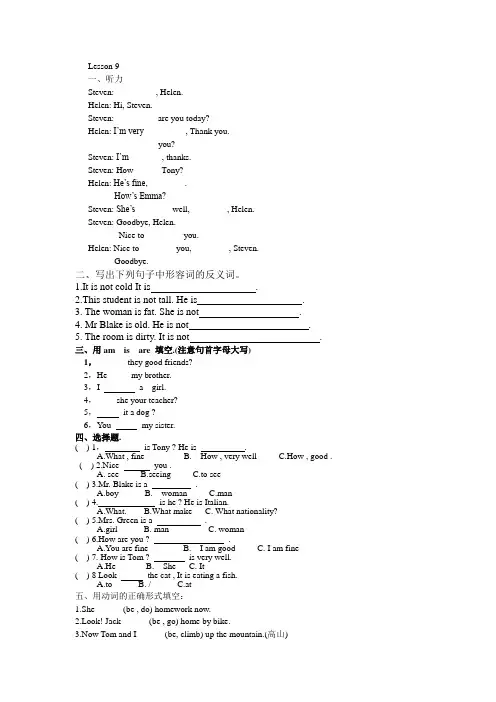
Lesson 9一、听力Steven: _________, Helen.Helen: Hi, Steven.Steven: _________ are you today?Helen: I’m very _________, Thank you.__________you?Steven: I’m _______, thanks.Steven: How______ Tony?Helen: He’s fine, ________.How’s Emma?Steven: She’s ________well, ________, Helen.Steven: Goodbye, Helen.Nice to ________ you.Helen: Nice to ________you, ________, Steven.Goodbye.二、写出下列句子中形容词的反义词。
1.It is not cold It is .2.This student is not tall. He is .3. The woman is fat. She is not .4. Mr Blake is old. He is not .5. The room is dirty. It is not .三、用am is are 填空.(注意句首字母大写)1,_____ they good friends?2,He _____my brother.3,I a girl.4,____ she your teacher?5,it a dog ?6,You my sister.四、选择题.( ) 1,is Tony ? He is .A.What , fineB. How , very wellC.How , good . ( ) 2.Nice you .A. seeB.seeingC.to see( ) 3.Mr. Blake is a .A.boyB. womanC.man( ) 4. is he ? He is Italian.A.What.B.What makeC. What nationality?( ) 5.Mrs. Green is a .A.girlB. manC. woman( ) 6.How are you ? .A.You are fineB. I am goodC. I am fine( ) 7. How is Tom ? is very well.A.HeB. SheC. It( ) 8 Look the cat , It is eating a fish.A.toB. /C.at五、用动词的正确形式填空:1.She ______(be , do) homework now.2.Look! Jack ______(be , go) home by bike.3.Now Tom and I ______(be, climb) up the mountain.(高山)4.Her mum ______(be, run) to the door now.5.He______(do not) like apples.6,Sam______(put) it under his arm.7.The boys _______(like) it.8.Kelly______(watch)TV every day.六、句型转换1、He is in the room.(一般疑问句)(否定句)2、They can play football.(一般疑问句)(否定句)七、阅读短文。
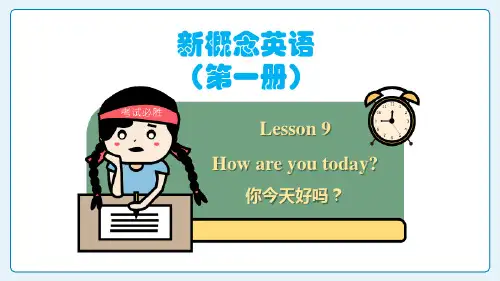

青少版新概念1A教案Unit9 Red, white and…pink! 红的、白的和粉红的!句型与结构词:课文注释:题目:Red, white and…pink!—代表英国的颜色是红色,白色和蓝色,所以红—白—蓝象征与英国有关的事物。
这里使用pink而不用blue是一种文字游戏。
图1:pyjamas—They are bright red! pyjamas是a pair of pyjamas的缩略语:没有单数形式,相应的代词和动词也要用复数。
注意复数词尾的发音:在元音后面-s发/z/音。
拼写:英式英语拼作pyjamas;美式英语拼作pajamas。
两种拼写方式都正确。
bright red—复合形容词。
bright是个形容词=“shining/reflecting light”,如:the bright sun。
但是,我们也用bright来强调表示颜色的形容词:bright red,bright yellow,bright green;在表示颜色的形容词前通常不用very。
a bit dirty—a bit,程度副词,与表语形容词(即用在动词后面的形容词)连用以减弱其程度,=“slightly”(有点儿)。
Here are Paul’s pyjamas—在以Here开头表示地点的句子中,名词主语(Paul’s pyjamas/Dad’s shirts)放在动词的后面:Here is+单数名词主语,Here are+复数名词主语。
(比较Here it is,见第15课:代词作主语时不倒装。
)图2:shirts—注意名词复数的发音:-s在/t/后发清辅音/s/。
pure white—复合形容词。
pure是一个形容词,通常用来修饰名词,但是在此处,它加强white 的程度。
(比较wide-awake)图5:Two lovely clean shirts!—lovely没有clean具体。
当名词前面有两个形容词时,不太具体的形容词放在前面,更具体的形容词紧挨着名词放在名词前面。
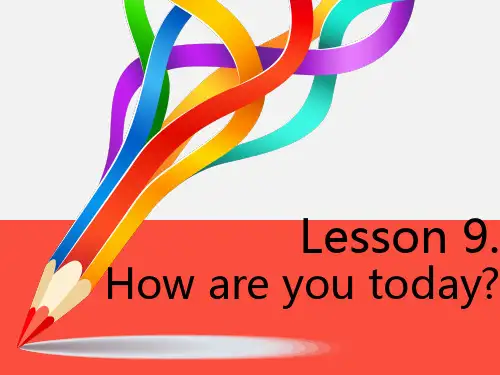

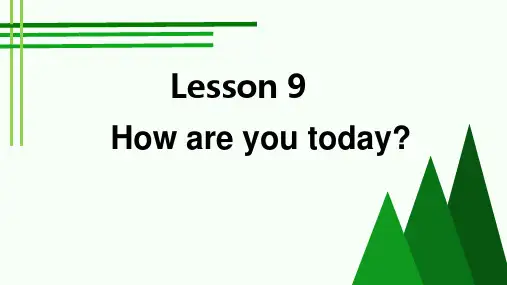
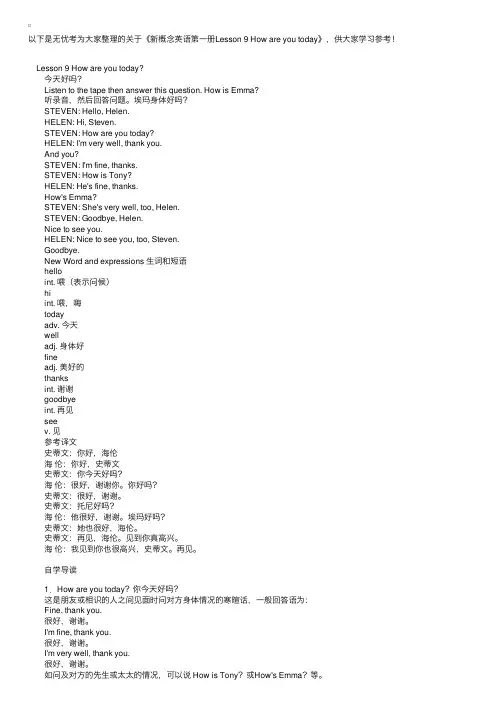
以下是⽆忧考为⼤家整理的关于《新概念英语第⼀册Lesson 9 How are you today》,供⼤家学习参考! Lesson 9 How are you today? 今天好吗? Listen to the tape then answer this question. How is Emma? 听录⾳,然后回答问题。
埃玛⾝体好吗? STEVEN: Hello, Helen. HELEN: Hi, Steven. STEVEN: How are you today? HELEN: I'm very well, thank you. And you? STEVEN: I'm fine, thanks. STEVEN: How is Tony? HELEN: He's fine, thanks. How's Emma? STEVEN: She's very well, too, Helen. STEVEN: Goodbye, Helen. Nice to see you. HELEN: Nice to see you, too, Steven. Goodbye. New Word and expressions ⽣词和短语 hello int. 喂(表⽰问候) hi int. 喂,嗨 today adv. 今天 well adj. ⾝体好 fine adj. 美好的 thanks int. 谢谢 goodbye int. 再见 see v. 见 参考译⽂ 史蒂⽂:你好,海伦 海伦:你好,史蒂⽂ 史蒂⽂:你今天好吗? 海伦:很好,谢谢你。
你好吗? 史蒂⽂:很好,谢谢。
史蒂⽂:托尼好吗? 海伦:他很好,谢谢。
埃玛好吗? 史蒂⽂:她也很好,海伦。
史蒂⽂:再见,海伦。
见到你真⾼兴。
海伦:我见到你也很⾼兴,史蒂⽂。
再见。
⾃学导读 1.How are you today?你今天好吗? 这是朋友或相识的⼈之间见⾯时问对⽅⾝体情况的寒暄话,⼀般回答语为: Fine, thank you. 很好,谢谢。
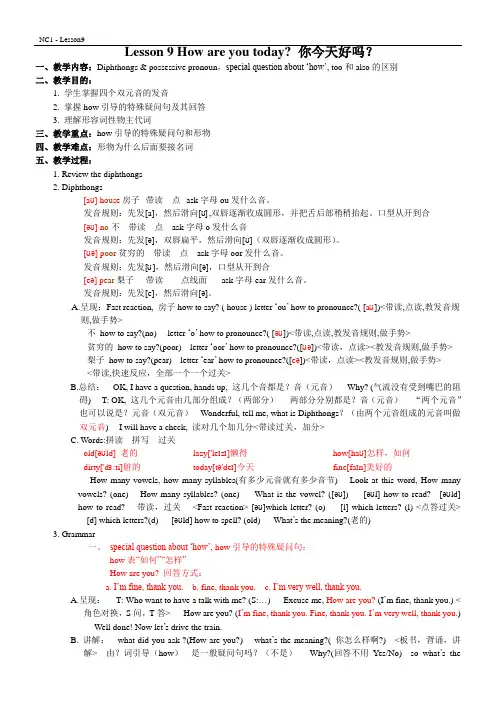
Lesson 9 How are you today? 你今天好吗?一、教学内容:Diphthongs & possessive pronoun,special question about ‘how’, too和also的区别二、教学目的:1. 学生掌握四个双元音的发音2. 掌握how引导的特殊疑问句及其回答3. 理解形容词性物主代词三、教学重点:how引导的特殊疑问句和形物四、教学难点:形物为什么后面要接名词五、教学过程:1. Review the diphthongs2. Diphthongs[aʊ] h ou se房子--带读---点--ask字母ou发什么音。
发音规则:先发[a],然后滑向[ʊ],双唇逐渐收成圆形,并把舌后部稍稍抬起。
口型从开到合[əʊ] n o不---带读---点---ask字母o发什么音发音规则:先发[ə],双唇扁平,然后滑向[ʊ](双唇逐渐收成圆形)。
[ʊə] p oor贫穷的---带读---点---ask字母oor发什么音。
发音规则:先发[ʊ],然后滑向[ə],口型从开到合[eə] p ear梨子----带读------点线面-----ask字母ear发什么音。
发音规则:先发[e],然后滑向[ə]。
A.呈现:Fast reaction, 房子how to say? ( house ) letter ‘ou’ how to pronounce?( [aʊ])<带读,点读,教发音规则,做手势>---不how to say?(no)--- letter ‘o’ how to pronounce?( [əʊ])<带读,点读,教发音规则,做手势>---贫穷的how to say?(poor)---letter ‘oor’ how to pronounce?([ʊə])<带读,点读><教发音规则,做手势>---梨子how to say?(pear)---letter ‘ear’ how to pronounce?([eə])<带读,点读><教发音规则,做手势>---<带读,快速反应,全部一个一个过关>B.总结:---OK, I have a question, hands up, 这几个音都是?音(元音)--- Why? (气流没有受到嘴巴的阻碍) ---T: OK, 这几个元音由几部分组成?(两部分)--- 两部分分别都是?音(元音)--- “两个元音”也可以说是?元音(双元音)---Wonderful, tell me, what is Diphthongs?(由两个元音组成的元音叫做双元音)--- I will have a check, 读对几个加几分<带读过关,加分>C. Words:拼读---拼写---过关old[əʊld] 老的lazy['leɪzɪ]懒得how[haʊ]怎样,如何dirty['dɜ:ti]脏的today[tə'deɪ]今天fine[faɪn]美好的--- How many vowels, how many syllables(有多少元音就有多少音节) ---Look at this word, How manyvowels? (one) ---How many syllables? (one) --- What is the vowel? ([əʊ]) --- [əʊl] how to read?---[əʊld]how to read? ---带读,过关--- <Fast reaction> [əʊ]which letter? (o) --- [l] which letters? (l) <点答过关>---[d] which letters?(d) --- [əʊld] how to spell? (old) --- What’s the meaning?(老的)3. Grammar一、special question about ‘how’, how引导的特殊疑问句:how表“如何”“怎样”How are you? 回答方式:a. I’m fine, thank you.b. fine, thank you.c. I’m very well, thank you.A.呈现:--- T: Who want to have a talk with me? (S:…) --- Excuse me, How are you? (I’m fine, thank you.) <角色对换,S问,T答> --- How are you? (I’m fine, thank you. Fine, thank you. I’m very well, thank you.)--- Well done! Now let’s drive the train.B. 讲解:---what did you ask ?(How are you?)--- what’s the meaning?( 你怎么样啊?)---<板书,背诵,讲解>---由?词引导(how)---是一般疑问句吗?(不是)--- Why?(回答不用Yes/No)---so what’s thesentence pattern?(特殊疑问句)---所以how是?词(特殊疑问词)---‘how’ what’s the meaning?(怎么样)--- How to answer? (I’m fine, thank you. Fine, thank you. I’m very well, thank you.)---<板书,带读,背诵>---Practice: Please think about: be动词有几种形式(三种)--- 哪三种(am, is , are)---用法?(单数is, 复数are, I am, you are不分家)---<回到how are you? 讲解you 配are>这里为什么用are, 不用别的be动词(因为这里后面是you)---如果换成he, be动词则用?(is)--- OK, let’s conclude. C. C→E: a.他好吗? b. Tony 好吗? c. Emma好吗?分别作答:二、形容词性物主代词possessive pronoun形容词性物主代词,简称形物a. 分为:my our your his her its their我的我们的你(们)的他的她的它的他们的b. 特点:形物后+名词c. It’s 和its的区别:it’s是it is 的缩写,表它是,its是形物,表示它的A. ---Please make a phrase:大的包(big bag)---“bag” what’s the meaning?(包) ---它是一个物体的名字,wecan call it?(名词)---“big” what’s the meaning?(大的)---用来形容一个物体怎么样的,we can call it?(形容词)---形容词修饰?词(名词)---you should remember it, I will check you.---E→C: It’s Helen’s bag.(这是Helen的包.)---<板书,背诵>---whose bag is it?( Helen的)---所以Helen 是这个包的?(主人) <T在BB上作标记>---now I will change this sentence:It’s my bag. what’s the meaning?(这是我的包)---还是我的包不?(是的)---my代替了?(Helen)---so we can call it?(代词)---Helen是物体的?(主人)---my代替了?(物体的主人)--- so we can call it? (物主代词) ---“bag”what’s the part of speech?(名词)---?词修饰名词(形容词)---这个句子中哪个词修饰bag?(my) --- 所以my虽然是物主代词但是具有?词性(形容词性)---所以我们可以叫它为?物主代词(形容词性物主代词)---为了简便点,给它取个绰号(形物)---还有其他的形物吗?hands up, if you are right you can get one point.B. --- Question: 什么是形物?(具有形容词性质的物主代词)--- 既然具有形容词性质,所以形物后要接?词(名词)---如果去掉这个名词,what’s the meaning? (它是我的) --- 句意还完整吗?(不完整)---所以形物后一定要?(加名词)C. --- “its”What’s the part of speech? (形物)---what’s the meaning?(它的)---<it’s and its what’re thedifferences? 要Ss观察出不同点,T再总结,如果Ss答不出来,则提示> ‘it’s’ what’s the meaning?(它是)---为什么有个逗号?(因为它是缩写)---是?的缩写(it is)---OK,let’s conclude.三、The usage of word: too & alsoa. 共同点:都表_______都用于_______句b. 不同点:too 放在句_______ also 放在句_________A. 呈现:A: I like apples. B: I like apples, too. C:I also like apples.(A: 我喜欢苹果。
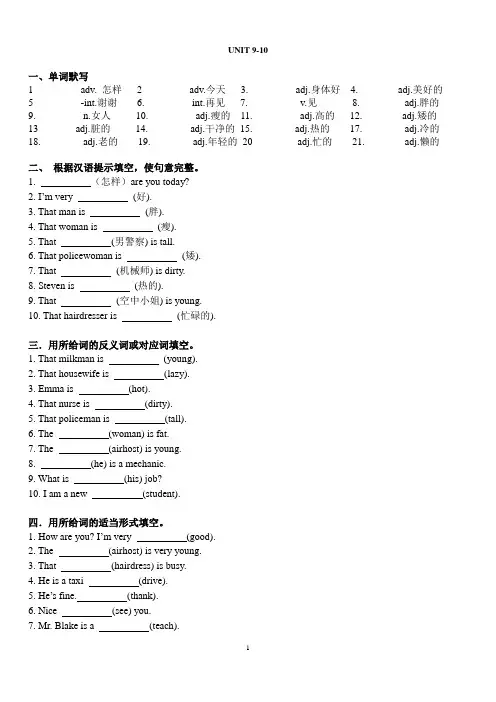
UNIT 9-10一、单词默写1_________ adv. 怎样2_________ adv.今天 3._________ adj.身体好 4.________adj.美好的5_________ -int.谢谢 6._________ int.再见7.__________ v.见8._________adj.胖的9._________ n.女人10._________ adj.瘦的11._________ adj.高的12.________adj.矮的13_______ adj.脏的14.________ adj.干净的15.________ adj.热的17.________ adj.冷的18.________ adj.老的19.________ adj.年轻的20 ________ adj.忙的21.________adj.懒的二、根据汉语提示填空,使句意完整。
1. (怎样)are you today?2. I’m very (好).3. That man is (胖).4. That woman is (瘦).5. That (男警察) is tall.6. That policewoman is (矮).7. That (机械师) is dirty.8. Steven is (热的).9. That (空中小姐) is young.10. That hairdresser is (忙碌的).三.用所给词的反义词或对应词填空。
1. That milkman is (young).2. That housewife is (lazy).3. Emma is (hot).4. That nurse is (dirty).5. That policeman is (tall).6. The (woman) is fat.7. The (airhost) is young.8. (he) is a mechanic.9. What is (his) job?10. I am a new (student).四.用所给词的适当形式填空。
零碎时间学英语新概念英语第一册第9课New Concept English Book 1 Lesson 9: She often goes swimmingToday, we will discuss Lesson 9 of the New Concept English Book 1, titled "She often goes swimming." This lesson focuses on reading comprehension and teaches us new vocabulary related to leisure activities.The lesson starts by introducing a woman named Ann. Ann is a housewife, and she has a passion for swimming. She goes swimming three times a week. Ann enjoys swimming because it keeps her physically fit, and she believes it is a good way to relax and forget her household chores for a while. She has made several friends at the swimming pool, and they often have a pleasant chat after swimming.Additionally, this lesson provides us with an opportunity to learn new vocabulary words and phrases. Let's explore some of them. 1. Housewife: Refers to a woman who stays at home to take care of the household and family.2. Passion: Strong enthusiasm or interest in something.3. Physically fit: In good physical condition, healthy and strong.4. Pleasant: Something that is enjoyable or gives satisfaction.5. Household chores: The tasks and duties related to managing a home, such as cleaning, cooking, and shopping.The lesson also introduces some new sentence structures and grammar points.1. Adverb of frequency: Ann goes swimming "often," indicating regularity in the action.2. Present Simple Tense: Ann says she "goes" swimming, which is used to talk about regular habits or routines.3. Prepositions: Ann relaxes "by" swimming, indicating the method or means used for relaxation.4. Conjunctions: "But" is used to contrast the relaxation of swimming with the responsibilities of being a housewife.To improve our understanding of the lesson, it is essential to practice reading it several times. It is also useful to take note of new words and phrases, and try using them in sentences. Furthermore, we can answer some comprehension questions to reinforce our understanding of the text:1. How often does Ann go swimming?2. Why does Ann enjoy swimming?3. What does Ann do after swimming?4. What is the meaning of "physically fit"?By engaging with the text and answering comprehension questions, we can reinforce our knowledge of the lesson and improve our reading and comprehension skills.Remember, practice is key when learning a new language. So, take the time to read and understand each lesson thoroughly, and practice using the new vocabulary words and grammar structuresin your own sentences. This will help you gradually become fluent in English.。